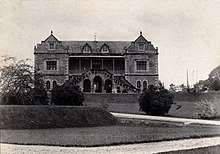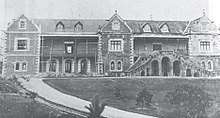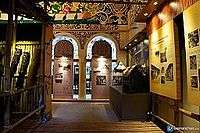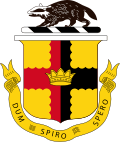Sarawak State Museum
| Muzium Negeri Sarawak | |
|
| |
| Established | Built in 1889. Open on 4 August 1891 |
|---|---|
| Location | Kuching, Sarawak, Malaysia |
| Coordinates | 1°33′17″N 110°20′37″E / 1.55472°N 110.34361°ECoordinates: 1°33′17″N 110°20′37″E / 1.55472°N 110.34361°E |
| Type | Ethnology museum |
| Founder | Charles Brooke |
| Owner | Sarawak state government |
| Website |
www |
The Sarawak State Museum (Malay: Muzium Negeri Sarawak) is the oldest museum in Borneo.[1] It was founded in 1888 and opened in 1891 in a purpose-built building in Kuching, Sarawak.[1] Naturalist Alfred Russel Wallace encouraged Charles Brooke, the second White Rajah of Sarawak, to establish the museum.[1]
Starting 23 October 2017, the museum is temporarily closed until 2020 for an RM308-million refurbishment works.[2] Once its reopened, the museum poised to become among the finest museums in ASEAN.[3]
History


Since the visit of Alfred Wallace, the Rajah of Sarawak was interested in the natural history of Sarawak and has been asking his officers to collect specimens throughout the state since 1878 so that he can build a museum on a future date. As the collections began to increase, the specimens were put inside a clock tower of a government office. Then, the specimens were moved to a room above an old vegetable market when H.B Low's collections arrived from the Rajang River. The room above the old vegetable market acted as a temporary museum and was open to the public. Finally, the proper Sarawak museum was built in 1889 and opened on 4 August 1891. The museum extended a new wing in 1911. However, the brick work steps outside the old wing was demolished in 1912. The building was built to permanently house and display local indigenous arts and crafts, and collections of local animals.[4]
During the Japanese Occupation, the museum was directed by a Japanese officer, who was sympathetic to its goals. He protected it and the museum suffered very little damage or looting.[4]
The historic building has been renovated. It is used to exhibit and interpret collections on the natural history of Sarawak. Shell Oil sponsored an exhibit on the petroleum industry, which has been important to Borneo. In addition, it displays archaeological artifacts and reconstructions of examples of the traditional life of the indigenous peoples, and of their arts and crafts. It has the most comprehensive archaeological, natural history, and ethnographic collections on Borneo.
Architecture
The building has undergone several renovations and alterations since its construction. It is rectangular, 44’ × 160’ with walls and pillars of bricks, and roof of belian and concrete. The museum building has european-style architecture with its edifice in Queen Anne style. The galleries were lighted up by dormer windows.[4][5] The galleries are lighted by dormer windows on the roof, making wall space available for exhibit displays and collections.
Layout

The ground floor of the museum holds the natural history collection and specimens of Sarawak fauna — reptiles, mammals, birds, etc., all expertly prepared and mounted for display. The west wing of the museum houses the Shell exhibition on the petroleum industries of Sarawak.
The first floor has exhibits of ethnographic artifacts of the indigenous peoples, such as models of the various types of longhouses, musical instruments, various kinds of fish and animal traps, handicrafts, models of boats and others.
Activities
The museum has been proclaimed guardian of the national patrimony, with the responsibility to search for, acquire and protect antiquities and historical monuments. The museum director is also responsible for protecting marine turtles and assisting the chief game warden in the conservation of wildlife.[6]
Museum journal
The Sarawak Museum Journal is published by the museum staff. It was first published in 1911, with John Moulton the inaugural editor, making it one of the oldest scientific journals of the South-East Asian region. Topics covered include the history, natural history and ethnology of the island of Borneo.
Curators and directors

Until 1974, the head of the museum was termed "Curator":
- J.E.A. Lewis — Pro tem Curator, acting from 25 June 1888 – 1902
- Dr George Darby Haviland — 26 February 1891 – 1 March 1893
- Edward Bartlett — 1 March 1893 – 22 July 1897
- Robert Walter Campbell Shelford — 22 July 1897 – 2 February 1905
- John Hewitt — 2 February 1905 – November 1908
- John Coney Moulton — November 1908 – 22 January 1915
- Mr Erman & K. H. Gillan — Officers in charge, 22 January 1915 – May 1922 (during WWI)
- Dr Eric Georg Mjöberg — May 1922 – 19 December 1924
- Gerard T.M. MacBryan — Acting Curator, 20 December 1924 – 24 January 1925
- Edward Banks — 20 February 1925 – 1945 (1942–1945 interned)
- Tom Harrisson — June 1947 – November 1966
- Benedict Sandin — December 1966 – March 1974
After this, "Director" was the title for the head of the museum:
- Lucas Chin — 1 April 1974 – December 1991
- Dr Peter M. Kedit – December 1991 – April 1996
- Sanib Said — May 1997 - December 2008
- Ipoi Datan - January 2009 – Present[2]
See also
Literature
- Lenzi, Iola (2004). Museums of Southeast Asia. Singapore: Archipelago Press. p. 200 pages. ISBN 981-4068-96-9.
References
- 1 2 3 Sulok Tawie (21 September 2017). "Sarawak Museum to close until 2020 for restoration". The Malay Mail Online.
- 1 2 Sharon Ling (23 September 2017). "Sarawak's old museum building to close until 2020". The Star Online.
- ↑ Peter Sibon (6 December 2017). "Poised to be one of the best in Asean". The Borneo Post Online.
- 1 2 3 Ah Chon, Ho (1948). Kuching in pictures (1841-1946) (PDF). Kuching: Sarawak state library (Pustaka Negeri Sarawak). pp. 42–43. Archived from the original (PDF) on 2 February 2018. Retrieved 2 February 2018.
- ↑ Patrica, Hului (7 August 2015). "Tracing the designs behind the Sarawak Museum". The Borneo Post. Archived from the original on 9 August 2015. Retrieved 9 August 2015.
- ↑ "Preserving Borneo's Traditions".
External links
| Wikimedia Commons has media related to Sarawak State Museum. |
